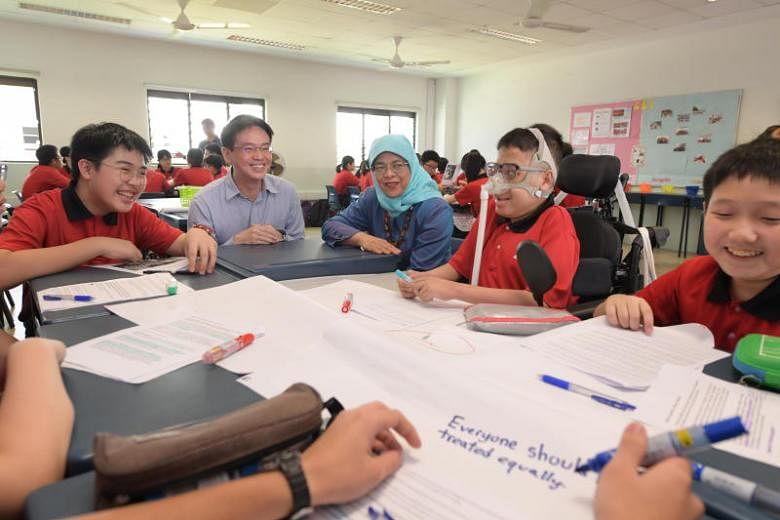SINGAPORE - Classmates Muhammad Aaron Irwan and Leroy Lim are always together in school.
Leroy, 13, helps to bring Aaron his food during recess and assists him with his schoolwork when he is unable to catch up.
The two boys are also tied by their common interest: playing the online mobile game Mobile Legends together.
Both Secondary 2 students at Zhenghua Secondary School, Leroy has been a designated buddy for over a year to Aaron, who suffers from muscular dystrophy.
Aaron, 16, moves around in a wheelchair and is only able to write for 10 minutes before it gets too physically taxing for him.
Leroy said: "When I first started eating with him, we pretty much had nothing in common.
"As time went by, we started playing mobile games together, studying together and I was accompanying him wherever he goes. Our friendship then grew closer."
Speaking while on a community engagement visit to Zhenghua Secondary School on Wednesday (April 17), President Halimah Yacob said that beyond school buildings and curriculum changes, peer-to-peer support was critical for students with special educational needs, like Aaron.
She commended the school's buddy system and pointed out that, without the understanding and support of their friends, students with special educational needs would feel marginalised and isolated and that, in turn, would impede their ability to integrate.
Zhenghua Secondary School is one of 35 mainstream secondary schools and junior colleges, including centralised institutes, that have been built or upgraded with facilities such as ramps and lifts for those with limited mobility.
The school also modifies its curriculum to accommodate the needs of students with physical disabilities, such as changing sports equipment so that wheelchair-bound students can take part.
Ms Judy Wee, senior manager at Muscular Dystrophy Association Singapore, agreed that making the curriculum accessible for wheelchair-bound students was key to inclusivity.
She noted that certain school subjects, like science and home economics, required students to participate hands-on but the design of equipment and furniture in classrooms made it difficult for wheelchair-bound students to do so.
For instance, the high tabletops and kitchen stoves in home economics classrooms were often out of reach of those in wheelchairs and also made it dangerous for them to carry out some tasks like chopping ingredients or cooking.
Ms Wee added that improving the designs such as having lower tabletops or height-adjustable tables, would ensure that these students were not left out in the lessons.
Currently, Aaron has to watch from the sidelines while his classmates participate in such activities.
Mr Eugene Lin, the school principal, said: "The school tries its best to get the students involved as much as possible.
"Those areas that are difficult to modify - they will be observers."
Leroy said that he felt for his buddy, Aaron, when he has to sit out physical education lessons in school.
"I hope the teachers can come up with a plan to involve him in PE lessons so that he can bond together with the class," Leroy said.


